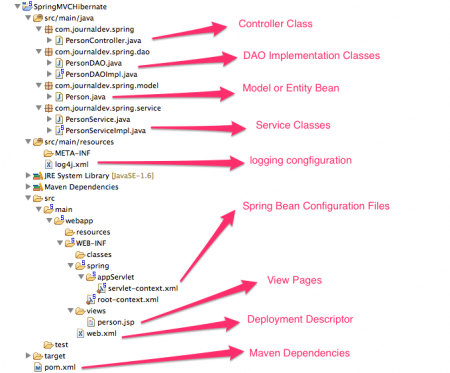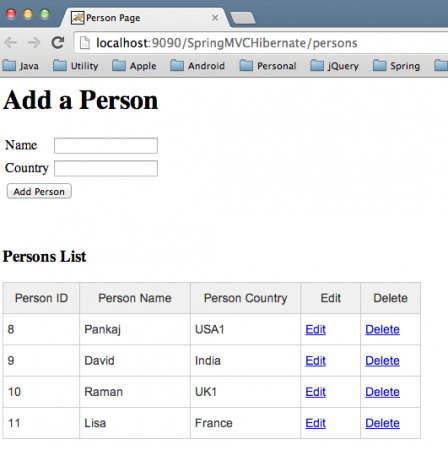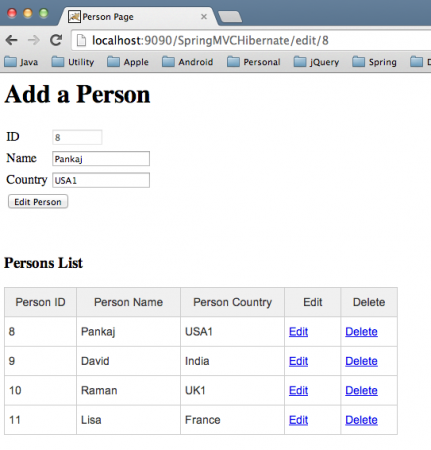Spring MVC Hibernate MySQL Integration CRUD Example
We learned how to integrate Spring and Hibernate in our last tutorial. Today we will move forward and integrate Spring MVC and Hibernate frameworks in a web application CRUD example. Our final project structure looks like below image, we will look into each of the components one by one.
Note that I am using Spring 4.0.3.Release and Hibernate 4.3.5.Final versions for our example, the same program is also compatible for Spring 4 and Hibernate 3, however you need to make small changes in spring bean configuration file.
Maven Dependencies
Let’s look at all the maven dependencies are required for hibernate and spring MVC framework integration.
<?xml version="1.0" encoding="UTF-8"?>
<project xmlns="https://maven.apache.org/POM/4.0.0" xmlns:xsi="https://www.w3.org/2001/XMLSchema-instance"
xsi:schemaLocation="https://maven.apache.org/POM/4.0.0 https://maven.apache.org/maven-v4_0_0.xsd">
<modelVersion>4.0.0</modelVersion>
<groupId>com.journaldev.spring</groupId>
<artifactId>SpringMVCHibernate</artifactId>
<name>SpringMVCHibernate</name>
<packaging>war</packaging>
<version>1.0.0-BUILD-SNAPSHOT</version>
<properties>
<java-version>1.6</java-version>
<org.springframework-version>4.0.3.RELEASE</org.springframework-version>
<org.aspectj-version>1.7.4</org.aspectj-version>
<org.slf4j-version>1.7.5</org.slf4j-version>
<hibernate.version>4.3.5.Final</hibernate.version>
</properties>
<dependencies>
<!-- Spring -->
<dependency>
<groupId>org.springframework</groupId>
<artifactId>spring-context</artifactId>
<version>${org.springframework-version}</version>
<exclusions>
<!-- Exclude Commons Logging in favor of SLF4j -->
<exclusion>
<groupId>commons-logging</groupId>
<artifactId>commons-logging</artifactId>
</exclusion>
</exclusions>
</dependency>
<dependency>
<groupId>org.springframework</groupId>
<artifactId>spring-webmvc</artifactId>
<version>${org.springframework-version}</version>
</dependency>
<dependency>
<groupId>org.springframework</groupId>
<artifactId>spring-tx</artifactId>
<version>${org.springframework-version}</version>
</dependency>
<!-- Hibernate -->
<dependency>
<groupId>org.hibernate</groupId>
<artifactId>hibernate-core</artifactId>
<version>${hibernate.version}</version>
</dependency>
<dependency>
<groupId>org.hibernate</groupId>
<artifactId>hibernate-entitymanager</artifactId>
<version>${hibernate.version}</version>
</dependency>
<!-- Apache Commons DBCP -->
<dependency>
<groupId>commons-dbcp</groupId>
<artifactId>commons-dbcp</artifactId>
<version>1.4</version>
</dependency>
<!-- Spring ORM -->
<dependency>
<groupId>org.springframework</groupId>
<artifactId>spring-orm</artifactId>
<version>${org.springframework-version}</version>
</dependency>
<!-- AspectJ -->
<dependency>
<groupId>org.aspectj</groupId>
<artifactId>aspectjrt</artifactId>
<version>${org.aspectj-version}</version>
</dependency>
<!-- Logging -->
<dependency>
<groupId>org.slf4j</groupId>
<artifactId>slf4j-api</artifactId>
<version>${org.slf4j-version}</version>
</dependency>
<dependency>
<groupId>org.slf4j</groupId>
<artifactId>jcl-over-slf4j</artifactId>
<version>${org.slf4j-version}</version>
<scope>runtime</scope>
</dependency>
<dependency>
<groupId>org.slf4j</groupId>
<artifactId>slf4j-log4j12</artifactId>
<version>${org.slf4j-version}</version>
<scope>runtime</scope>
</dependency>
<dependency>
<groupId>log4j</groupId>
<artifactId>log4j</artifactId>
<version>1.2.15</version>
<exclusions>
<exclusion>
<groupId>javax.mail</groupId>
<artifactId>mail</artifactId>
</exclusion>
<exclusion>
<groupId>javax.jms</groupId>
<artifactId>jms</artifactId>
</exclusion>
<exclusion>
<groupId>com.sun.jdmk</groupId>
<artifactId>jmxtools</artifactId>
</exclusion>
<exclusion>
<groupId>com.sun.jmx</groupId>
<artifactId>jmxri</artifactId>
</exclusion>
</exclusions>
<scope>runtime</scope>
</dependency>
<!-- @Inject -->
<dependency>
<groupId>javax.inject</groupId>
<artifactId>javax.inject</artifactId>
<version>1</version>
</dependency>
<!-- Servlet -->
<dependency>
<groupId>javax.servlet</groupId>
<artifactId>servlet-api</artifactId>
<version>2.5</version>
<scope>provided</scope>
</dependency>
<dependency>
<groupId>javax.servlet.jsp</groupId>
<artifactId>jsp-api</artifactId>
<version>2.1</version>
<scope>provided</scope>
</dependency>
<dependency>
<groupId>javax.servlet</groupId>
<artifactId>jstl</artifactId>
<version>1.2</version>
</dependency>
<!-- Test -->
<dependency>
<groupId>junit</groupId>
<artifactId>junit</artifactId>
<version>4.7</version>
<scope>test</scope>
</dependency>
</dependencies>
<build>
<plugins>
<plugin>
<artifactId>maven-eclipse-plugin</artifactId>
<version>2.9</version>
<configuration>
<additionalProjectnatures>
<projectnature>org.springframework.ide.eclipse.core.springnature</projectnature>
</additionalProjectnatures>
<additionalBuildcommands>
<buildcommand>org.springframework.ide.eclipse.core.springbuilder</buildcommand>
</additionalBuildcommands>
<downloadSources>true</downloadSources>
<downloadJavadocs>true</downloadJavadocs>
</configuration>
</plugin>
<plugin>
<groupId>org.apache.maven.plugins</groupId>
<artifactId>maven-compiler-plugin</artifactId>
<version>2.5.1</version>
<configuration>
<source>1.6</source>
<target>1.6</target>
<compilerArgument>-Xlint:all</compilerArgument>
<showWarnings>true</showWarnings>
<showDeprecation>true</showDeprecation>
</configuration>
</plugin>
<plugin>
<groupId>org.codehaus.mojo</groupId>
<artifactId>exec-maven-plugin</artifactId>
<version>1.2.1</version>
<configuration>
<mainClass>org.test.int1.Main</mainClass>
</configuration>
</plugin>
</plugins>
<finalName>${project.artifactId}</finalName>
</build>
</project>
Some of the dependencies above are included by STS (Spring Tool Suite) when I create Spring MVC project. Important dependencies above are spring-context, spring-webmvc, spring-tx, hibernate-core, hibernate-entitymanager and spring-orm. I am using Apache Commons DBCP for connection pooling, but in real life situations, most probably you have connection pooling done by the container and all we need is to provide the JNDI reference details to use. NOTE: I noticed that some of the readers are getting database connection issues. Notice that in my pom.xml, there is no database driver. That works for me because I have MySQL driver in tomcat lib directory and some DataSource connections configured with it. For any database connection related issues, either put the database driver in container lib or include that in pom.xml dependencies.
Deployment Descriptor
We need to plugin the spring framework in our web application, that is done by configuring Spring framework DispatcherServlet as the front controller. Our web.xml file looks like below.
<?xml version="1.0" encoding="UTF-8"?>
<web-app version="2.5" xmlns="https://java.sun.com/xml/ns/javaee"
xmlns:xsi="https://www.w3.org/2001/XMLSchema-instance"
xsi:schemaLocation="https://java.sun.com/xml/ns/javaee https://java.sun.com/xml/ns/javaee/web-app_2_5.xsd">
<!-- The definition of the Root Spring Container shared by all Servlets and Filters -->
<context-param>
<param-name>contextConfigLocation</param-name>
<param-value>/WEB-INF/spring/root-context.xml</param-value>
</context-param>
<!-- Creates the Spring Container shared by all Servlets and Filters -->
<listener>
<listener-class>org.springframework.web.context.ContextLoaderListener</listener-class>
</listener>
<!-- Processes application requests -->
<servlet>
<servlet-name>appServlet</servlet-name>
<servlet-class>org.springframework.web.servlet.DispatcherServlet</servlet-class>
<init-param>
<param-name>contextConfigLocation</param-name>
<param-value>/WEB-INF/spring/appServlet/servlet-context.xml</param-value>
</init-param>
<load-on-startup>1</load-on-startup>
</servlet>
<servlet-mapping>
<servlet-name>appServlet</servlet-name>
<url-pattern>/</url-pattern>
</servlet-mapping>
</web-app>
Most of the part is boilerplate code, most important part is the spring context file location where we will configure our spring beans and services. If you want, you can change them according to your project requirements.
Hibernate Entity Bean
We are using JPA annotations in our entity bean class, however, we can also have a simple java bean and mapping details in the XML file. In that case, we need to provide mapping file details while configuring Hibernate SessionFactory in spring bean configurations.
package com.journaldev.spring.model;
import javax.persistence.Column;
import javax.persistence.Entity;
import javax.persistence.GeneratedValue;
import javax.persistence.GenerationType;
import javax.persistence.Id;
import javax.persistence.Table;
/**
* Entity bean with JPA annotations
* Hibernate provides JPA implementation
* @author pankaj
*
*/
@Entity
@Table(name="PERSON")
public class Person {
@Id
@Column(name="id")
@GeneratedValue(strategy=GenerationType.IDENTITY)
private int id;
private String name;
private String country;
public int getId() {
return id;
}
public void setId(int id) {
this.id = id;
}
public String getName() {
return name;
}
public void setName(String name) {
this.name = name;
}
public String getCountry() {
return country;
}
public void setCountry(String country) {
this.country = country;
}
@Override
public String toString(){
return "id="+id+", name="+name+", country="+country;
}
}
MySQL Table Creation Script
Our entity bean maps to PERSON table in MySQL database, notice that I have not annotated “name” and “country” fields with @Column annotation because they are of the same name. Below SQL script shows the table details.
CREATE TABLE `Person` (
`id` int(11) unsigned NOT NULL AUTO_INCREMENT,
`name` varchar(20) NOT NULL DEFAULT '',
`country` varchar(20) DEFAULT NULL,
PRIMARY KEY (`id`)
) ENGINE=InnoDB AUTO_INCREMENT=1 DEFAULT CHARSET=utf8;
PersonDAO Interface
package com.journaldev.spring.dao;
import java.util.List;
import com.journaldev.spring.model.Person;
public interface PersonDAO {
public void addPerson(Person p);
public void updatePerson(Person p);
public List<Person> listPersons();
public Person getPersonById(int id);
public void removePerson(int id);
}
Hibernate-Specific DAO Implementation
package com.journaldev.spring.dao;
import java.util.List;
import org.hibernate.Session;
import org.hibernate.SessionFactory;
import org.slf4j.Logger;
import org.slf4j.LoggerFactory;
import org.springframework.stereotype.Repository;
import com.journaldev.spring.model.Person;
@Repository
public class PersonDAOImpl implements PersonDAO {
private static final Logger logger = LoggerFactory.getLogger(PersonDAOImpl.class);
private SessionFactory sessionFactory;
public void setSessionFactory(SessionFactory sf){
this.sessionFactory = sf;
}
@Override
public void addPerson(Person p) {
Session session = this.sessionFactory.getCurrentSession();
session.persist(p);
logger.info("Person saved successfully, Person Details="+p);
}
@Override
public void updatePerson(Person p) {
Session session = this.sessionFactory.getCurrentSession();
session.update(p);
logger.info("Person updated successfully, Person Details="+p);
}
@SuppressWarnings("unchecked")
@Override
public List<Person> listPersons() {
Session session = this.sessionFactory.getCurrentSession();
List<Person> personsList = session.createQuery("from Person").list();
for(Person p : personsList){
logger.info("Person List::"+p);
}
return personsList;
}
@Override
public Person getPersonById(int id) {
Session session = this.sessionFactory.getCurrentSession();
Person p = (Person) session.load(Person.class, new Integer(id));
logger.info("Person loaded successfully, Person details="+p);
return p;
}
@Override
public void removePerson(int id) {
Session session = this.sessionFactory.getCurrentSession();
Person p = (Person) session.load(Person.class, new Integer(id));
if(null != p){
session.delete(p);
}
logger.info("Person deleted successfully, person details="+p);
}
}
Notice that I am not using Hibernate Transaction, that is because it will be taken care by Spring framework.
Spring Service Classes
package com.journaldev.spring.service;
import java.util.List;
import com.journaldev.spring.model.Person;
public interface PersonService {
public void addPerson(Person p);
public void updatePerson(Person p);
public List<Person> listPersons();
public Person getPersonById(int id);
public void removePerson(int id);
}
package com.journaldev.spring.service;
import java.util.List;
import org.springframework.stereotype.Service;
import org.springframework.transaction.annotation.Transactional;
import com.journaldev.spring.dao.PersonDAO;
import com.journaldev.spring.model.Person;
@Service
public class PersonServiceImpl implements PersonService {
private PersonDAO personDAO;
public void setPersonDAO(PersonDAO personDAO) {
this.personDAO = personDAO;
}
@Override
@Transactional
public void addPerson(Person p) {
this.personDAO.addPerson(p);
}
@Override
@Transactional
public void updatePerson(Person p) {
this.personDAO.updatePerson(p);
}
@Override
@Transactional
public List<Person> listPersons() {
return this.personDAO.listPersons();
}
@Override
@Transactional
public Person getPersonById(int id) {
return this.personDAO.getPersonById(id);
}
@Override
@Transactional
public void removePerson(int id) {
this.personDAO.removePerson(id);
}
}
Notice that spring declarative transaction management is applied by using @Transactional annotation.
Spring Controller Class
Our DAO and Service classes are ready, it’s time to write our controller class that will take care of client requests and uses service classes to perform database specific operations and then returns the view pages.
package com.journaldev.spring;
import org.springframework.beans.factory.annotation.Autowired;
import org.springframework.beans.factory.annotation.Qualifier;
import org.springframework.stereotype.Controller;
import org.springframework.ui.Model;
import org.springframework.web.bind.annotation.ModelAttribute;
import org.springframework.web.bind.annotation.PathVariable;
import org.springframework.web.bind.annotation.RequestMapping;
import org.springframework.web.bind.annotation.RequestMethod;
import com.journaldev.spring.model.Person;
import com.journaldev.spring.service.PersonService;
@Controller
public class PersonController {
private PersonService personService;
@Autowired(required=true)
@Qualifier(value="personService")
public void setPersonService(PersonService ps){
this.personService = ps;
}
@RequestMapping(value = "/persons", method = RequestMethod.GET)
public String listPersons(Model model) {
model.addAttribute("person", new Person());
model.addAttribute("listPersons", this.personService.listPersons());
return "person";
}
//For add and update person both
@RequestMapping(value= "/person/add", method = RequestMethod.POST)
public String addPerson(@ModelAttribute("person") Person p){
if(p.getId() == 0){
//new person, add it
this.personService.addPerson(p);
}else{
//existing person, call update
this.personService.updatePerson(p);
}
return "redirect:/persons";
}
@RequestMapping("/remove/{id}")
public String removePerson(@PathVariable("id") int id){
this.personService.removePerson(id);
return "redirect:/persons";
}
@RequestMapping("/edit/{id}")
public String editPerson(@PathVariable("id") int id, Model model){
model.addAttribute("person", this.personService.getPersonById(id));
model.addAttribute("listPersons", this.personService.listPersons());
return "person";
}
}
Notice that I am using @Controller annotation, so that Spring framework will treat it as a Controller class to handle client requests. Also I am using @Autowired and @Qualifier annotations for injecting PersonService, we could have done it in the spring context xml file too.
Spring Bean Configuration
Our services are ready, all we need is to wire them through spring bean configurations. Our root-context.xml file is empty, so we will look only into the servlet-context.xml file.
<?xml version="1.0" encoding="UTF-8"?>
<beans:beans xmlns="https://www.springframework.org/schema/mvc"
xmlns:xsi="https://www.w3.org/2001/XMLSchema-instance" xmlns:beans="https://www.springframework.org/schema/beans"
xmlns:context="https://www.springframework.org/schema/context" xmlns:tx="https://www.springframework.org/schema/tx"
xsi:schemaLocation="https://www.springframework.org/schema/mvc https://www.springframework.org/schema/mvc/spring-mvc.xsd
https://www.springframework.org/schema/beans https://www.springframework.org/schema/beans/spring-beans.xsd
https://www.springframework.org/schema/context https://www.springframework.org/schema/context/spring-context.xsd
https://www.springframework.org/schema/tx https://www.springframework.org/schema/tx/spring-tx-4.0.xsd">
<!-- DispatcherServlet Context: defines this servlet's request-processing
infrastructure -->
<!-- Enables the Spring MVC @Controller programming model -->
<annotation-driven />
<!-- Handles HTTP GET requests for /resources/** by efficiently serving
up static resources in the ${webappRoot}/resources directory -->
<resources mapping="/resources/**" location="/resources/" />
<!-- Resolves views selected for rendering by @Controllers to .jsp resources
in the /WEB-INF/views directory -->
<beans:bean
class="org.springframework.web.servlet.view.InternalResourceViewResolver">
<beans:property name="prefix" value="/WEB-INF/views/" />
<beans:property name="suffix" value=".jsp" />
</beans:bean>
<beans:bean id="dataSource" class="org.apache.commons.dbcp.BasicDataSource"
destroy-method="close">
<beans:property name="driverClassName" value="com.mysql.jdbc.Driver" />
<beans:property name="url"
value="jdbc:mysql://localhost:3306/TestDB" />
<beans:property name="username" value="pankaj" />
<beans:property name="password" value="pankaj123" />
</beans:bean>
<!-- Hibernate 4 SessionFactory Bean definition -->
<beans:bean id="hibernate4AnnotatedSessionFactory"
class="org.springframework.orm.hibernate4.LocalSessionFactoryBean">
<beans:property name="dataSource" ref="dataSource" />
<beans:property name="annotatedClasses">
<beans:list>
<beans:value>com.journaldev.spring.model.Person</beans:value>
</beans:list>
</beans:property>
<beans:property name="hibernateProperties">
<beans:props>
<beans:prop key="hibernate.dialect">org.hibernate.dialect.MySQLDialect
</beans:prop>
<beans:prop key="hibernate.show_sql">true</beans:prop>
</beans:props>
</beans:property>
</beans:bean>
<beans:bean id="personDAO" class="com.journaldev.spring.dao.PersonDAOImpl">
<beans:property name="sessionFactory" ref="hibernate4AnnotatedSessionFactory" />
</beans:bean>
<beans:bean id="personService" class="com.journaldev.spring.service.PersonServiceImpl">
<beans:property name="personDAO" ref="personDAO"></beans:property>
</beans:bean>
<context:component-scan base-package="com.journaldev.spring" />
<tx:annotation-driven transaction-manager="transactionManager"/>
<beans:bean id="transactionManager" class="org.springframework.orm.hibernate4.HibernateTransactionManager">
<beans:property name="sessionFactory" ref="hibernate4AnnotatedSessionFactory" />
</beans:bean>
</beans:beans>
dataSource bean is defined for org.apache.commons.dbcp.BasicDataSource class for basic connection pooling. org.springframework.orm.hibernate4.LocalSessionFactoryBean bean is used for Hibernate 4 SessionFactory. For Hibernate 3, you will find similar classes as org.springframework.orm.hibernate3.LocalSessionFactoryBean and org.springframework.orm.hibernate3.AnnotationSessionFactoryBean.
One important point is that when we are depending on Spring framework for Hibernate Session management, we should not define hibernate.current_session_context_class, otherwise, you will get a lot of session transaction-related issues. personDAO and personService beans are self understood.
transactionManager bean definition for org.springframework.orm.hibernate4.HibernateTransactionManager is required for Spring ORM to support hibernate session transaction management. For Hibernate 3, you will find similar class as org.springframework.orm.hibernate3.HibernateTransactionManager. Spring uses AOP for transaction management, you can now relate it with@Transactiona annotation.
View Page
Our last part of the application is the view page, notice the attributes added to Model in Controller handler methods, we will use them to create our view page. We will also use JSTL tags, spring core and spring form tags.
<%@ taglib uri="https://java.sun.com/jsp/jstl/core" prefix="c" %>
<%@ taglib uri="https://www.springframework.org/tags" prefix="spring" %>
<%@ taglib uri="https://www.springframework.org/tags/form" prefix="form" %>
<%@ page session="false" %>
<html>
<head>
<title>Person Page</title>
<style type="text/css">
.tg {border-collapse:collapse;border-spacing:0;border-color:#ccc;}
.tg td{font-family:Arial, sans-serif;font-size:14px;padding:10px 5px;border-style:solid;border-width:1px;overflow:hidden;word-break:normal;border-color:#ccc;color:#333;background-color:#fff;}
.tg th{font-family:Arial, sans-serif;font-size:14px;font-weight:normal;padding:10px 5px;border-style:solid;border-width:1px;overflow:hidden;word-break:normal;border-color:#ccc;color:#333;background-color:#f0f0f0;}
.tg .tg-4eph{background-color:#f9f9f9}
</style>
</head>
<body>
<h1>
Add a Person
</h1>
<c:url var="addAction" value="/person/add" ></c:url>
<form:form action="${addAction}" commandName="person">
<table>
<c:if test="${!empty person.name}">
<tr>
<td>
<form:label path="id">
<spring:message text="ID"/>
</form:label>
</td>
<td>
<form:input path="id" readonly="true" size="8" disabled="true" />
<form:hidden path="id" />
</td>
</tr>
</c:if>
<tr>
<td>
<form:label path="name">
<spring:message text="Name"/>
</form:label>
</td>
<td>
<form:input path="name" />
</td>
</tr>
<tr>
<td>
<form:label path="country">
<spring:message text="Country"/>
</form:label>
</td>
<td>
<form:input path="country" />
</td>
</tr>
<tr>
<td colspan="2">
<c:if test="${!empty person.name}">
<input type="submit"
value="<spring:message text="Edit Person"/>" />
</c:if>
<c:if test="${empty person.name}">
<input type="submit"
value="<spring:message text="Add Person"/>" />
</c:if>
</td>
</tr>
</table>
</form:form>
<br>
<h3>Persons List</h3>
<c:if test="${!empty listPersons}">
<table class="tg">
<tr>
<th width="80">Person ID</th>
<th width="120">Person Name</th>
<th width="120">Person Country</th>
<th width="60">Edit</th>
<th width="60">Delete</th>
</tr>
<c:forEach items="${listPersons}" var="person">
<tr>
<td>${person.id}</td>
<td>${person.name}</td>
<td>${person.country}</td>
<td><a href="<c:url value='/edit/${person.id}' />" >Edit</a></td>
<td><a href="<c:url value='/remove/${person.id}' />" >Delete</a></td>
</tr>
</c:forEach>
</table>
</c:if>
</body>
</html>
Spring MVC Hibernate Application Testing
Just build and deploy the project into any servlet container of your choice, for example, Tomcat. Below screenshots shows the view pages for our application.
You will also find similar logs in the server log file.
Hibernate: insert into PERSON (country, name) values (?, ?)
INFO : com.journaldev.spring.dao.PersonDAOImpl - Person saved successfully, Person Details=id=15, name=Pankaj, country=USA
Hibernate: select person0_.id as id1_0_, person0_.country as country2_0_, person0_.name as name3_0_ from PERSON person0_
INFO : com.journaldev.spring.dao.PersonDAOImpl - Person List::id=10, name=Raman, country=UK2
INFO : com.journaldev.spring.dao.PersonDAOImpl - Person List::id=11, name=Lisa, country=France
INFO : com.journaldev.spring.dao.PersonDAOImpl - Person List::id=15, name=Pankaj, country=USA
Summary
This tutorial was aimed to provide sufficient details for you to getting started with Spring MVC and Hibernate integration, I hope you will find it useful.





